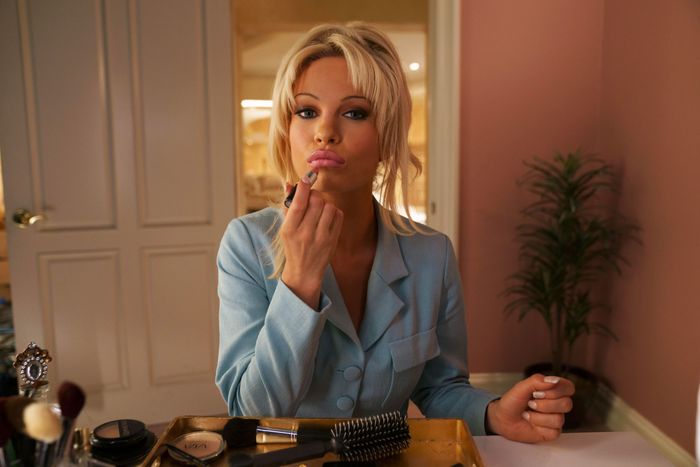
In the ’90s, it was practically an urban legend. Pamela Anderson and Tommy Lee’s first date was in Cancún. They took ecstasy, stared into each other’s eyes for two days, and swiftly found an officiant to marry them. The wedding party was small, consisting of girls the bride and groom had met the night before at a local bikini contest, the winner serving as maid of honor. The ceremony was held on the beach, where a crowd recognized the famous couple and formed around them. After they were pronounced husband and wife, the groom lifted the bride, who wore a white bikini, and carried her into the ocean. Spring breakers followed them into the waves, swimming around the couple as they kissed. In lieu of rings, Pam and Tommy exchanged tattoos: “Pamela” on his dick and “Tommy” on her ring finger.
As is their nature, urban myths tend to shift over time, adapting to fit new cultural mores. The above summary (based on an interview with Pamela Anderson in Tommyland, Lee’s memoir) is not exactly the wedding depicted in Pam & Tommy, a new scripted series by Hulu. The miniseries trades the bikini-contest girls for BFFs, and there is no dick tattoo. Billing itself in ads as “The Greatest Love Story Ever Sold,” it promises an account of the couple, their quickie marriage, and their infamous sex-tape leak under the guise of cultural restitution (a trendy framework for recent TV). It’s a reevaluation of the media’s treatment of Anderson, one that’s meant to square specifically with Gen-Z and millennial viewers steeped in strains of online feminism.
But Pam & Tommy takes a true-crime approach to its subject matter, based as it is on a Rolling Stone story about the carpenter who stole the couple’s sex tape and leaked it to the early internet, where it took two years to go viral. The show, produced without the consent of Anderson or Lee, opens with a sympathetic close-focus shot of the carpenter, played by Seth Rogen, who, after not being paid for construction on Lee’s Malibu mansion, is remade as a sort of spiritual leftist with reason enough to rob the couple. It’s karma. The Pam and Tommy of the show aren’t given the benefit of the same interiority, embodied by little more than prosthetics: a literal talking dick and a medical-grade silicone breastplate. Lily James — “whoever she is,” as Courtney Love said in a Facebook post criticizing the show — doesn’t play Anderson so much as a fantasy of her, all baby talk and empty smiles. A breathy flash of veneers. We know why the carpenter did it, but three-quarters of the way through the series, we’re no closer to understanding why the couple, and especially Anderson, maintained such a psychic hold of the public at large.
If Pamela Anderson and Tommy Lee are part of a great love story, it’s set in a specific time and place. Clinton had just been elected on the principle of “It’s the economy, stupid.” The dot-com bubble, yet to burst, created upper-middle-class jobs while welfare “reform” pushed many Americans to extreme levels of poverty and hunger. When he wasn’t playing the saxophone on Arsenio Hall, the president was talking about his crime bill and a push for more police. Meanwhile, TV public-service announcements warned, “You know you can get AIDS from heterosexual sex? Anyone can get HIV. Anyone.”
In came Pamela and Tommy Lee, hounded by paparazzi, appearing as though in a perpetual sex daze, like the VHS cover for a sexual thriller. Their celebrity channeled an image of all-encompassing passion, arousing both anxiety and interest among a rubbernecking public steeped in fiscally conservative family-values messaging. It was an image of falling all the way into love with its emotional, spiritual, and sexual extremes — using the position of being alive, however briefly, to experience as much joy and intensity as possible. “They spent money like they hated it,” the real-life carpenter Rand Gauthier told Rolling Stone.
When asked about preparing to play Anderson, James said she reached out to Anderson but never got a call back. The real Pamela Anderson was accessible, though. She was a savvy social-media user before she quit Instagram, Facebook, and Twitter last year and is outwardly leftist. She is creative, sharing poems on her website. As for her relationship with Lee, she describes their connection in his memoir Tommyland as more of a shared joie de vivre. They lived a life marked by private artistic pursuits, writing screenplays for each other and throwing mock themed weddings together — a space-themed wedding, a New Age wedding, a wedding on Christmas in which Lee rode in on a horse and the couple signed the guest book in each other’s blood “because it felt like forever.”
The character James and the Pam & Tommy writers created without Anderson is far more simple. Pam is the nice girl who fell for the wrong guy. She’s the SWERF fantasy: a woman so used to pleasing men that she can’t stand up for herself. All we see are the tropes: Pam’s the pinup, she’s the bombshell, she’s the bimbo. The show clings to that tabloid fantasy of two people with little in common beyond the desire to fuck each other without digging any deeper, casting Anderson as blank as possible so that a new public’s conscious and repressed desires could be projected onto her all over again. Taking on the damage of a repressed bisexual nation is hard work. (Anderson survived it; Marilyn Monroe did not.) But doing it twice in one lifetime doesn’t mean you’ve been redeemed by anyone.
The “redemption” arc in Pam & Tommy comes in two speeches that have yet to air, though commenting on them now won’t spoil anything. First, the character of Pamela, in a shaky voice, explains something we already know happened in real life: The court denied her control over the distribution of her image in the form of the sex tape. “Sluts — and that’s what this ruling is saying I am, in case you’re unclear — don’t get to decide what happens to pictures of their body,” she says. It’s Pam’s big scene, yet it falls flat, the delivery automated. The knowledge that Anderson herself did not sign off on the use of her (nude, prosthetic) image for the show has an uncanny-valley effect. The second speech comes when the leftist straw man, the carpenter, doing a little soul-searching in the face of mob threats, admits that Pam “did nothing wrong.” From episode one, we are made to understand why he stole and leaked the tape, but for a supposedly sympathetic and thoughtful character, this admission feels paper-thin.
While the show’s pose of class consciousness via Rogen’s character is current to discourse, the flattening of Anderson’s story isn’t. New generations respond to Anderson because of shifted values. Women online have come to claim the term bimbo. Their politics are influenced by the hard-won visibility of sex workers who fought against stigma, moving discussions of sex work from the realm of sexual politics into the realm of labor. If millennial feminists don’t already have some cultural memory of Pam’s sex tape, they can probably recall Kim Kardashian West’s. A millennial herself, she came of age in an era of free online porn, a time when girls were warned about creating sexual images of themselves: What if your kids see it one day? It’s a question that seems outdated now when a growing number of women are signing up for OnlyFans. And besides, what girl with a dating app on her phone hasn’t at least sent nudes?
Every generation must discover sex for themselves, but rather than bring the Gen-Z viewer with no memory of this sex-tape scandal into the actual adult world of 2022 where Pamela Anderson currently lives, the series introduces the story washed in an ethos of the past with only a slight change: The bombshell isn’t a slut, and she isn’t asking for it. She’s actually a victim. But it’s just another trope inside of which the same violence takes place. Pam is stifled. The mores might have changed for women raised to view a two-salary household as a feminist win, who put off marrying to build a career and require a longer dating period with more sexual partners. What’s unchanged is that the bimbo and the bad boy, the whore and her co-conspirator, remain characters in a morality tale as told by social conservatives — whether on the left or the right, the story is a cautionary one. Pam remains a threat to an economic system underpinned by the top-down promotion of family values. She is the trespasser, an intruder.
But there’s another legend wherein Pamela’s character is seen as more of a warrior. Wherein “The Greatest Love Story Ever Sold” contains one truth: Only by destroying traditional marriage can you remake it on the basis of love. Typically, this isn’t the stuff of true crime, but one could imagine a series that studies the resourcefulness and drive of a character like Pam and arrives somewhere more radical — this show did not.




